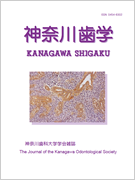- HOME
- > 一般の方
- > バックナンバー:神奈川歯学
- > 27巻3号
- > アブストラクト
アブストラクト(27巻3号:神奈川歯学)

Japanese
| Title : | 歯の動揺にかかわる付着歯肉の影響 |
|---|---|
| Subtitle : | 原著 |
| Authors : | 倉林典之, 北條了, 松尾悦郎 |
| Authors(kana) : | |
| Organization : | 神奈川歯科大学歯科補綴学教室第I講座 |
| Journal : | 神奈川歯学 |
| Volume : | 27 |
| Number : | 3 |
| Page : | 337-349 |
| Year/Month : | 1992 / 12 |
| Article : | 原著 |
| Publisher : | 神奈川歯科大学学会 |
| Abstract : | 「緒言」装着された補綴装置を生体組織の緩衝能の働く範囲以内で機能させる為には, 生体と調和の取れた義歯設計を生体側と義歯側の各々の観点から配慮する必要がある. とくに残存歯に加わった力は, 生理的範囲以内であれば歯周組織の緩衝能, 咀嚼の反射機能で為害性の少ないものとして頭蓋へ伝達される. それが限界を越えた場合には歯周疾患に伴う歯の動揺や顎関節の異常等の原因となる. しかし, 現状で歯の緩衝能に関する値をみつけだすには, 生体で歯に外力を与えて発生する疼痛との関係から生理的外力の限界を推測するか, または生理的状態で機能している時の外力の大きさを求めて参考とするより方法がない. 従来から, これらについて生体以外を対象とした解析研究は多岐にわたって行なわれ, 鬼頭, 川崎, Wright, Eick, Brightらが歪み計や光弾性実験を用い研究を行ってきたが, これらは静的荷重による模型実験あるいは動物実験が殆どである. |
| Practice : | 歯科学 |
| Keywords : | 付着歯肉, 歯の動揺, 義歯 |
English
| Title : | The Effects of Attached Gingiva on The Mobility of The Teeth |
|---|---|
| Subtitle : | |
| Authors : | Noriyuki KURABAYASHI, Satoru HOJYO, Etsuro Matsuo |
| Authors(kana) : | |
| Organization : | The 1st Department of Prosthetic Dentistry, Kanagawa Dental College |
| Journal : | Kanagawa Shigaku |
| Volume : | 27 |
| Number : | 3 |
| Page : | 337-349 |
| Year/Month : | 1992 / 12 |
| Article : | Original article |
| Publisher : | Kanagawa Odontological Society |
| Abstract : | Abstract : The disruption of coordination among the teeth, periodontal tissues, and the worn prosthesis can cause very serious effects on the living body. So far, almost no method has been available that makes it possible to obtain reliable values to grasp the buffering capability of the teeth. Under these circumstances, we have been conducting research on the external shock alleviating ability of the teeth by focusing attention on the tooth-supporting soft tissue. The research involved the investigation of the relationships between tooth movements and the conditions of the gingiva in contact with the teeth by performing model analyses on the head of a carcass. The results are described below. 1. The modal analyses recognized the presence of two different vibration modes : the mode#1(63Hz to 125Hz in the frequency range) and the mode#2(500Hz to 1KHz). 2. Removal of the gingiva led to a slight increase of the resonance frequency in the teeth toward higher frequency range. This indicates that the attached gingiva plays a role in reducing the external shock. 3. The kinetic observation by applying impact to the specimen at an angle of zero degree before removal of the attached gingiva and after the removal founda parallel shift in the rigid body vibration mode [curves] in the mode#1 vibration. When a zero angle impact was applied to exposed teeth roots and when an impact was given under three different testing conditions bykeeping the angle at 30 degrees, a vibration mode was observed in which the impacted teeth deviated momentarily from the dental arch accompanied with vibration phase differences. In the case of the mode#2 vibration, a compound vibration mode composed of a torsion and the rigid body mode vibration was detected when impact was given at zero angle. When impacted at an angle of 30 degrees, a similar compound mode vibration was observed with the axis of the vibration located near the ends of teeth roots. 4. As for the degree of vibration displacement, the 30 degree impacting caused displacements ranging between 75.4 and 89.9μm, about twice larger than the displacement (41.0 to 45.7μm) for zero angle impacting. Removal of the attached gingiva caused particularly large displacements at the 30 degree impacting. 5. The attached gingiva sticking to the teeth and the periodontal tissues affect the movements of the teeth in terms of the displacement, though the degree of displacement is not large enough to change the resonance frequency and the mobility of the teeth substantially. |
| Practice : | Dentistry |
| Keywords : |
